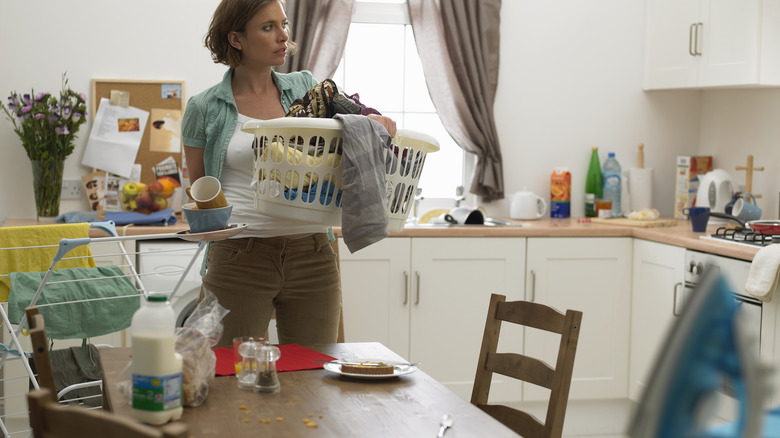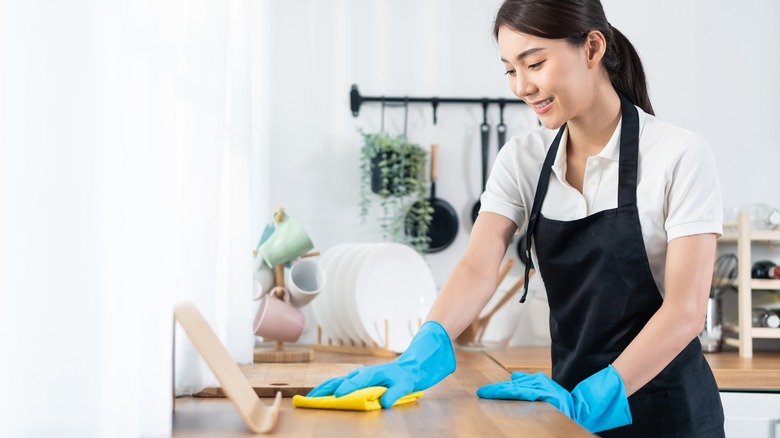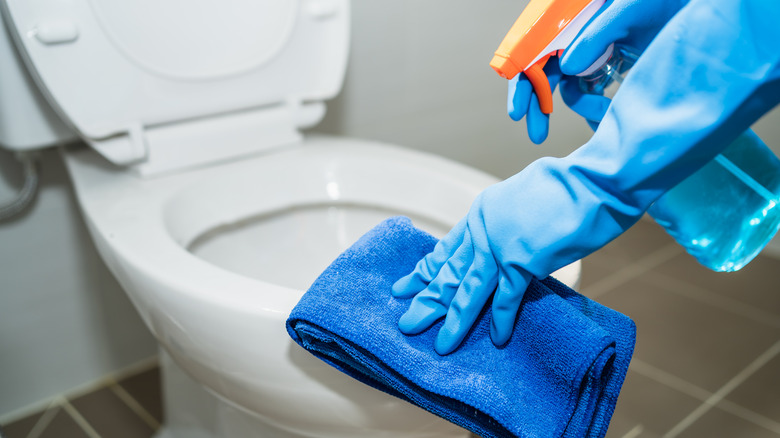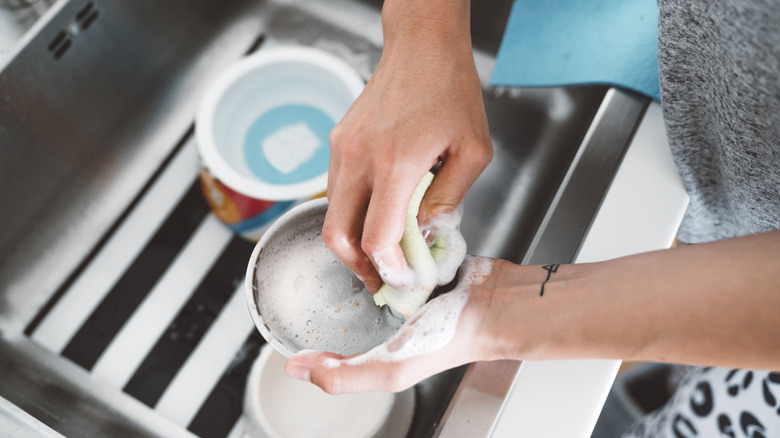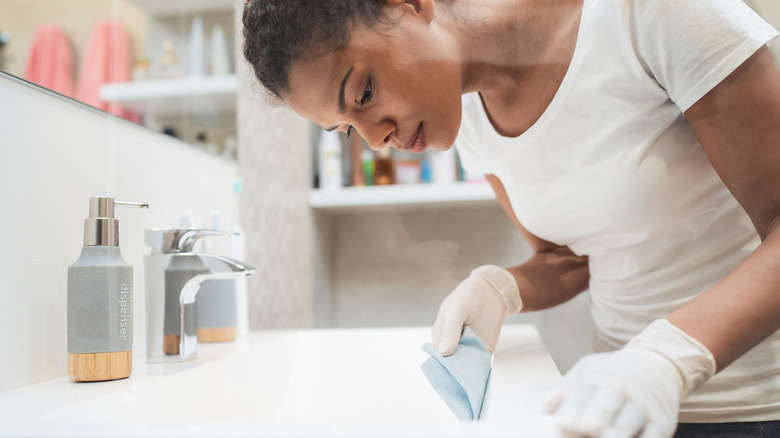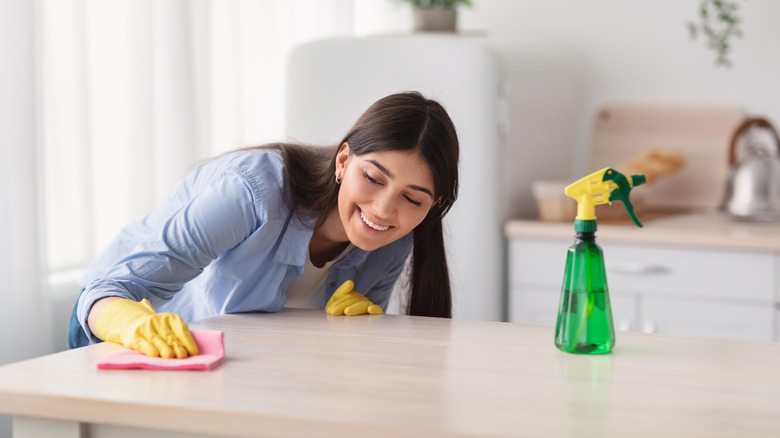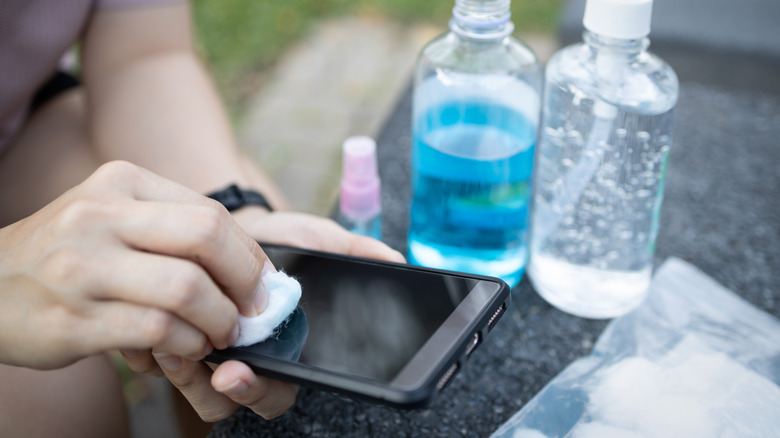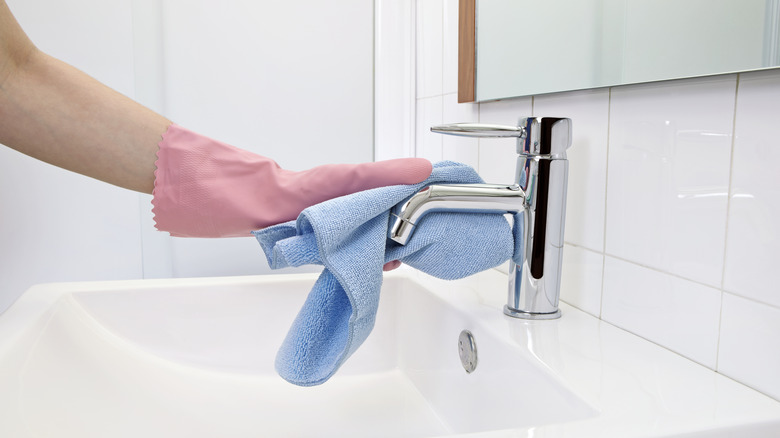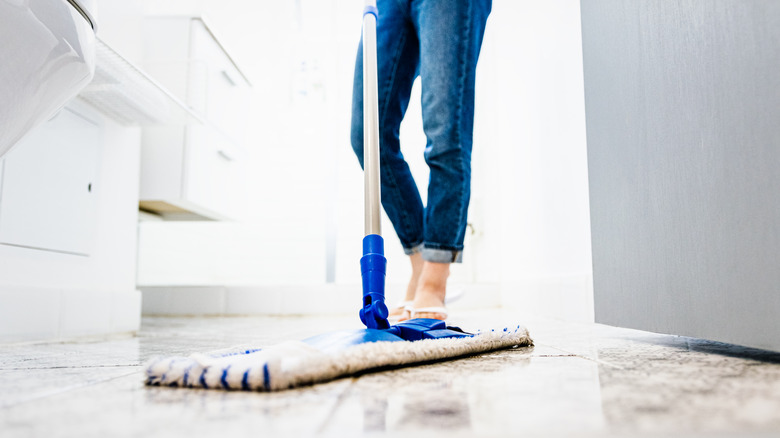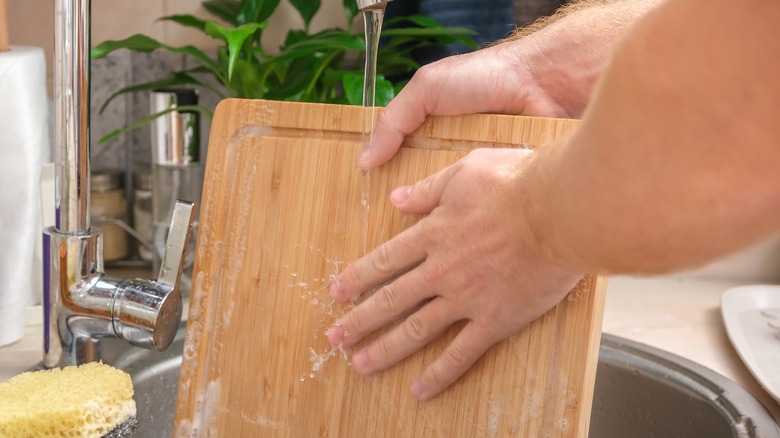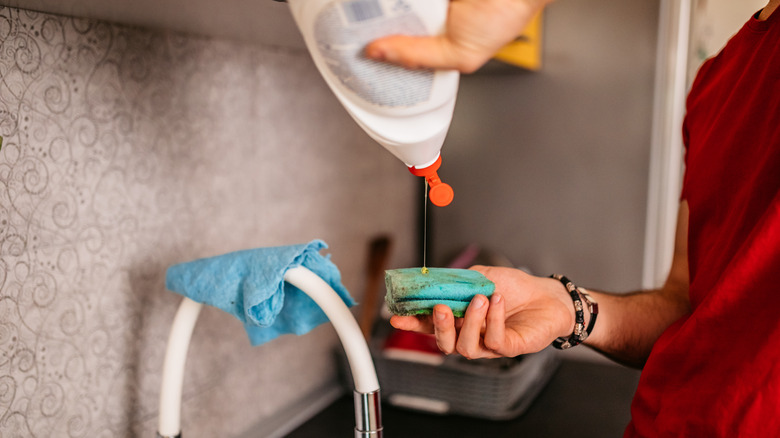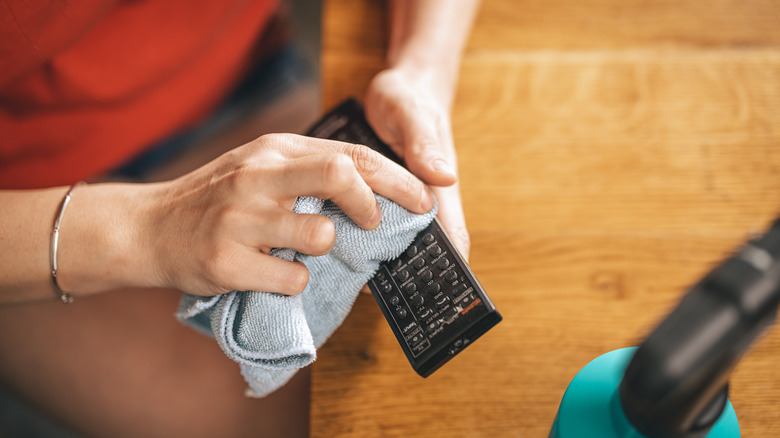11 Things In Your House You Should Be Cleaning Daily
We may receive a commission on purchases made from links.
Keeping your home clean is more than just a chore; it's an essential part of living a healthy and comfortable life. Every day, without realizing it, we encounter various areas in our homes that can harbor germs, dust, and grime. The persistence of these bacteria is something to be mindful of. A 2006 study published in the journal "BMC Infectious Diseases" revealed that E. coli can hang around for up to 16 months on surfaces. Staph is just as tenacious, with a survival rate of up to 7 months. And then there's Salmonella typhimurium, which can last for four years. These aren't just numbers; they're reasons to be diligent about disinfecting your sinks, countertops, and various surfaces.
These bacteria aren't just minor nuisances — they can significantly impact our health and well-being. But don't worry; maintaining a clean home doesn't have to be overwhelming or time-consuming. With the right approach, you can efficiently tackle these areas, ensuring your home stays sanitary and inviting. Remember, the goal is not to turn your home into a sterile environment but to manage the cleanliness with some simple and effective minimal cleaning hacks. For instance, cleaning your pet's bowls daily or sanitizing your cutting boards thoroughly can prevent the spread of harmful bacteria. Similarly, paying attention to often-overlooked items like kitchen sponges or your cell phone can make a significant difference in your home's overall hygiene. Here is what you should be cleaning daily.
Clean the kitchen counters daily to prevent attracting pests
Your kitchen counters are prime targets for ants and cockroaches due to food crumbs and spills. And these pests aren't just icky; they're like tiny disease-delivery systems, spreading germs wherever they roam, especially in your kitchen. According to a 2011 NSF study, salmonella and E. coli were found on 32% of countertops, which both pests are known to spread at high rates. To keep pests at bay, wipe down the counters daily with a disinfectant cleaner. This not only cleans away any potential bug-luring food crumbs, but also nixes any bacteria that is beginning to grow. You can invest in disinfectant wipes to make the process convenient and efficient, though you can't use those on natural stone counters such as granite and marble. That's because the acid in the product can etch their surfaces. Instead, use 70% rubbing alcohol on those surfaces.
After each meal, a quick wipe will do the job. However, when possible, try to give it a good, firm scrub to deep clean it. Focus on high-traffic areas, like around the sink, on the island where you chop, and near the stove.
Remove grime and dirt from the toilet daily
Here's a less glamorous but essential daily task: keeping your toilet clean. You want to do a super fast wipe-down of the seat and handle daily, and for good reason. The seat is a hotspot for not-so-pleasant things like urine splashes. These aren't just unsightly; they can lead to yellow stains and, frankly, a bit of a stink over time. Furthermore, bacteria and germs love to hang out on it, and a daily scrub helps keep them in check. But don't worry; keeping on top of this doesn't have to be a big ordeal.
All you need to do is keep a disinfectant spray or can of wipes conveniently stashed in your vanity so you can quickly wipe down the commode each day. For the seat, you not only need to wipe down the top, but also lift it and get underneath. A lot of grime and urine buildup happens here, and it's a spot that's easy to overlook. Make sure you also get into those crevices and hinges where urine and germs like to hide. But why stop at just the seat? While you're at it, take a moment to wipe down the toilet handle. It's a high-touch area and can also be a breeding ground for germs.
Clean pet bowls daily
Let's talk about your furry friend's dining area, specifically their bowls. You might not know this, but according to NSF International, dog dishes rank as the fourth germiest item in our homes. Surprising, right? Interestingly, that viscous layer you feel when you pick up your pet's bowl is called "biofilm." It contains harmful bacteria like salmonella, E. coli, MRSA, and listeria. It's not just about keeping your pet healthy; it's also about protecting the entire family. So, what's the best way to tackle this? The Food and Drug Administration (FDA) has some clear guidelines: Wash your pet's food dishes after the day is done. It sounds like a big commitment, but it makes a world of difference.
Give your pet bowls a good scrub with hot, soapy water. Make sure you really get in there, removing any traces of that biofilm. Then, to disinfect it, soak it in 1 gallon of water amended with 1/3 cup bleach. Rinse the bowls afterward to remove any chemical residues. If you have a dishwasher, even better. Just pop the bowls in there for a thorough clean on the sanitizing cycle. This routine not only keeps the bowls sparkling but also ensures that you're minimizing the risk of bacteria spreading around your home.
Disinfect the sinks daily
Believe it or not, around 45% of kitchen sinks harbor bacteria like salmonella and E. coli, according to NSF International. Think about it — every time you handle raw meat and then wash your hands or rinse off those chicken breasts, you're potentially leaving behind some unwelcome bacterial guests. And it's not just the kitchen. Your bathroom sink can accumulate fecal particles from handwashing. Yes, it's a bit unsettling to think about, but awareness is the first step to prevention.
Make daily disinfection of your sinks a non-negotiable part of your routine. It's easier than it sounds. Keep a bottle of disinfectant spray or some wipes right under the sink. This way, they're always handy for a quick wipe-down of the basin and drain. You can then give your bathroom a deep clean once a week. Your kitchen sink also needs thorough cleaning, and you can use the same disinfecting products to tackle its basin, drain, and surrounding rim. Remember, it's not about going overboard and turning your home into a sterile environment. It's about smart, regular cleaning to keep those pesky germs at bay.
The dining table harbors particles and spills
Leftover food on the dining table offers another breeding ground for bacteria. And depending on what your table is made of, the way you clean it can make a big difference in keeping it both hygienic and in good condition. If you have a wood dining table, keep the cleaning routine simple. After each meal, mix some dish soap with warm water. Grab a microfiber cloth and gently wipe down the surface to remove any food particles and spills. Remember, wood is porous, so it's important to avoid letting moisture linger. This means wiping it down thoroughly so you don't end up with moisture buildup, which can damage the wood over time.
If you have glass tables, here's a neat trick: mix some warm water with a bit of baking soda to remove sticky or dried messes. Use a non-abrasive sponge to gently clean the surface. Once you've tackled any spots or spills, go over it with a glass spray to remove any streaks. Now, if you're working with a metal table, the approach is slightly different. Use a soap and water mixture along with a soft sponge. Don't use anything abrasive, or else it will scratch the surface. To disinfect the different materials, simply mix a 1:1 ratio of water and vinegar in a spray bottle and use that to keep germs at bay.
Computers, cell phones, and tablets harbor germs
Here's one topic that's more relevant now than ever: Keeping your smartphones and tablets clean. It's no secret that we're glued to our devices. A 2018 Deloitte study highlighted just how attached we are, revealing that Americans check their phones about 52 times a day. What's more, a 2016 FDA study found that nearly half of consumers use these devices while preparing food. But here's the kicker: Cell phones can carry 10 times more bacteria than most toilet seats. That means you're spreading bacteria around every time you use one of your screens.
But don't panic; there's a simple solution to keep these germs in check. Here's what you need to do: Make it a daily habit to disinfect your mobile devices. It's easy and effective. All you need is an alcohol wipe. Gently wipe down your smartphone or tablet with it. Now, while doing this, be sure to power off your device and avoid getting moisture in any openings. Give special attention to the screen and the back, and don't forget the sides, where your hands often rest. Doing this daily is crucial, especially if you're someone who uses their phone or tablet in the kitchen or if you're someone who's constantly on the move.
Wipe down all faucet handles at the end of each day
Whether in your kitchen or bathroom, faucet handles can harbor a surprising amount of bacteria and mold. Think about it: every time you handle food, touch dirty surfaces, or wipe your hands on a towel, your next stop is usually the faucet. And that's how these germs get there. In the kitchen, the underside of faucet handles can accumulate all sorts of stuff — food debris from your hands, grime from towels, or just everyday germs. This buildup isn't just unsightly; it's a breeding ground for bacteria once again. And let's not forget about the bathroom faucet. This is a critical area, especially considering bacterial infections can spread via feces particles, which are commonly found on your bathroom taps. It's not the most pleasant thought, but it's an important one for maintaining a hygienic home.
Use some disinfecting wipes to give those handles a thorough wipe-down. Make sure you get all sides, especially the underside, where gunk tends to hide. If you want to take it a step further, consider using an EPA Safer Choice disinfecting cleaner. These cleaners are made with environmentally safe ingredients that are also safer for your health. Such a disinfectant is Clorox Commercial Solutions Hydrogen Peroxide Disinfecting Cleaner, which you can get for $12 at Amazon.
Your bathroom floors accumulate dirt and debris
One area of your home that's a breeding ground for bacteria yet often gets the least attention is the floors, particularly in your kitchen and bathroom. You might not realize it, but these floors can harbor some pretty nasty germs. A study by Mira Showers, in collaboration with the School of Biological Sciences at Bristol University, found an astonishing amount of bacteria on bathroom floors, including streptococcus, E.coli, salmonella, and staphylococcus.
Now, let's talk solutions. When cleaning your bathroom floor, bleach is your best friend. In studies, bleach has been shown to reduce bacteria-infected areas by a whopping 99.4%. Here's your action plan: First, sweep or vacuum the floor to remove any loose dirt or debris. Then, mix a bleach-based cleaning solution; the recommended mixture is a 1:3 bleach-to-water ratio. Wipe your bathroom floor, giving extra attention to areas around the toilet and sink, where bacteria are more likely to be present, and let the floor dry. However, if you have stone floors — such as marble tile ones — you cannot use bleach or else it will cause etching. Instead, sanitize your floors with rubbing alcohol. Mix a 3:1 solution of water and rubbing alcohol in a bucket, and use that to sanitize your floors.
Cutting boards harbor bacteria
A kitchen essential that demands meticulous care is the cutting board. Whether you prefer plastic or wood, these boards are crucial for your meal prep, but they also pose a risk if not maintained properly. Over time, cutting boards can develop deep grooves from knife cuts, and these tiny crevices are perfect hideouts for bacteria. This isn't just a theory; a 2006 study in the "Journal of AOAC International" highlighted this critical point. It's especially true in the case of plastic boards. When cleaning your board, start with the basics — dish soap and warm water. But to really sanitize the board, especially after using it for raw meat, use distilled white vinegar or 3% hydrogen peroxide. These are potent sanitizers that can help keep your board germ-free. Have these bottles out on your counter so you can easily use them to wipe down your board daily.
Now, here are some key dos and don'ts: Don't soak the board in water. This is especially important when cleaning wooden cutting boards as they're porous and tend to expand. And remember, wood cutting boards should never go in the dishwasher. The high heat and moisture in dishwashers can damage the wood. Be vigilant when cutting raw meat to prevent the juice from seeping through the board. After cutting raw meat, try to sanitize the board immediately. Finally, keep an eye on the condition of your cutting board. If it becomes heavily scarred or grooved, it's time to replace it.
Sanitize your sponges thoroughly
Let's now focus on a small but mighty kitchen tool: the sponge. A 2018 study published in the "Italian Journal of Food Safety" sheds light on an often-overlooked fact: Kitchen sponges transfer a scary amount of germs. They can spread spoilage bacteria and dangerous pathogens, which are responsible for foodborne diseases. That's right, the very tool you use to clean your dishes and countertops could be counterintuitively spreading germs. You can easily reduce the risk of spreading harmful bacteria by cleaning your sponges daily. This doesn't mean just giving them a quick rinse under the tap. You need to properly sanitize them.
According to the United States Department of Agriculture (USDA), the two most effective methods are either microwaving or dishwashing your sponges. This kills 99.9% of the bacteria on them. Put it in the microwave for 1 minute on the highest setting, or add it to the dishwasher when you're using the hottest setting. Remember, a damp sponge is a breeding ground for bacteria. So, after each use, squeeze out all the excess water and store it in a dry place.
Your remote controls have more dirt than you think
You might not realize it, but your home remote could be harboring more germs than you think. In a revealing 2012 study by the American Society for Microbiology, remote controls were identified as the most contaminated items in hotel rooms, often coated in fecal matter and a host of germs. While your home environment is different from a hotel, the frequent use and seldom cleaning of remote controls make them a germ hotspot in households, too. So, how do you tackle this often-overlooked germ haven? The answer is simpler than you might expect: rubbing alcohol. It's an effective sanitizer that's easy to use and quickly kills germs. Get a paper towel, pour a small amount of rubbing alcohol on it, and thoroughly wipe down your remote. Make sure to cover every inch, front and back, and pay special attention to the buttons and any crevices. These areas may be more susceptible to accumulating germs due to frequent touching.
The beauty of using rubbing alcohol is its rapid evaporation rate, which means your remote won't stay wet for long. However, it's crucial to let it air dry completely before you use it again. This step ensures that the alcohol has enough time to effectively kill the germs. Remember, this isn't about being obsessive, but about being mindful of the cleanliness of frequently used items in your home.
